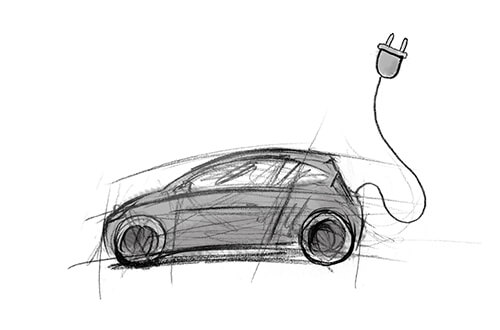|
|
|
|
|
|
|
|

Alternative Drive Types series: Rechargeable car batteries and fuel cells
In Germany, being able to move around as an individual is very important and motor vehicles are part of most people's everyday private and professional lives. Two particularly promising approaches have emerged internationally to achieve the energy transition away from fossil fuels and towards alternative types of drives, which is necessary from an ecological perspective. Find out which alternative drive types with rechargeable car batteries are available and what their advantages and disadvantages are.
The keypoints in short
- Using alternative drive systems can significantly reduce fossil fuel consumption when driving and, as a result, CO2 emissions, which harm the environment.
- Vehicles with rechargeable car batteries not only emit no pollutants, they are also pleasantly quiet.
- Hydrogen or fuel cell cars are equipped with a power unit that converts hydrogen into electrical energy that feeds the car's e-drive.
- Purchasing a modern electric vehicle is currently very interesting from a financial perspective. Many EU states are rewarding people for switching to an alternative drive type.
Alternative drive types – a big win for environmental protection
The era of fossil fuels is inevitably drawing to a close. Non-renewable and highly pollutive energy sources are being replaced by alternatives that have a much lower impact on both the environment and human health. Highly qualified teams around the world are researching alternative energy sources that are environmentally compatible and affordable.
In the field of alternative drive systems for passenger cars and commercial vehicles, two variants have turned out to be particularly promising. Rechargeable car batteries are already being installed by numerous manufacturers today. Currently, the most widespread batteries are lithium-ion batteries. This battery technology is also found in many cordless tools and household appliances. The second particularly promising variant of the alternative drive types is the fuel cell. With this technology, the electricity required is only generated in the vehicle when it is needed for movement.
Full of energy: Plug-in-hybrids and mild hybrids
If a hybrid car is equipped with a rechargeable car battery that powers the electric motor, it is also called a plug-in hybrid. The battery is recharged via the widely accessible low-voltage grid. Plug-in hybrids have a significantly more powerful electric motor and a larger battery than full hybrid vehicles. This allows them to drive faster and further in pure electric mode, i.e. between 30 and 60 kilometres. Plug-in hybrids are therefore particularly suitable for local journeys.
The current battery generation is based on lithium ion technology. Users with their own property usually install their own wallbox to recharge the car battery in their parking space or in the garage and may be able to benefit from cost-effective electricity rates. If this option is not available, they have to use a public charging station. The costs for recharging are then usually higher. The charging network is continuing to grow: within one year, over 5,000 new charging points were built.
Not only can vehicles use the energy from petrol, diesel and the like, but they can also run on electricity.
A variant combining a combustion and electric drive is called a mild hybrid and is currently a popular choice. This is a vehicle with an internal combustion engine that receives assistance from an electric motor when required. Mild hybrids can save 15 to 25 percent in fuel compared to petrol vehicles by recovering energy and feeding it back into the battery. The combustion engine is then expected to always operate at optimum efficiency. The generator converts surplus energy, which can get lost through heat during braking, for example, and stores it in the battery.
The technology specialist HELLA has also done convincing development work in this area. With the dual-voltage battery management system and the PowerPack 48 Volt, which is specially adapted to the requirements of mild hybrid vehicles, HELLA once again demonstrates that it is possible to make progress in climate protection with the appropriate expertise at all stages of electrification.
Attractive alternative hydrogen – fuel cell instead of petrol
Carmakers have long focussed on hydrogen as a potential energy carrier. One variant that is not dissimilar to the technology of a conventional combustion engine is the hydrogen combustion engine. This motor technology uses hydrogen instead of fossil fuels. The second, more modern variant relies on hydrogen as an energy carrier for fuel cell drives. In the process, electrical energy is generated through the oxidation of hydrogen, which in turn supplies the car's electric drive with energy.
At present, hydrogen-powered cars are not yet considered competitive. However, many experts argue that the acquisition costs are comparably higher because there are still very few cars of this type. With increasing popularity, hydrogen technology is seen as having the potential to compete with battery-powered electric drives. Another hurdle that hydrogen-powered cars currently face is the lack of charging infrastructure.
However, the disadvantages are also offset by some major advantages. While rechargeable batteries are extremely large, heavy and expensive, especially in heavy goods transportation, hydrogen can be used much more efficiently as an energy carrier. Moreover, refuelling a hydrogen-powered vehicle hardly takes more time than refuelling a petrol or diesel vehicle.
Vehicles can also be powered by hydrogen.
Many countries offer state subsidies
If you decide to purchase a vehicle with an alternative drive system, the German government will support you in your purchase with generous premiums. Currently, you can enjoy an environmental bonus and an innovation bonus in Germany. Many EU states are supporting people who switch to an alternative drive type. In some countries, bans on combustion engines are being discussed or have even already been passed. In Norway, for example, vehicles with alternative drive systems will be the only new vehicles to be registered from 2025.




